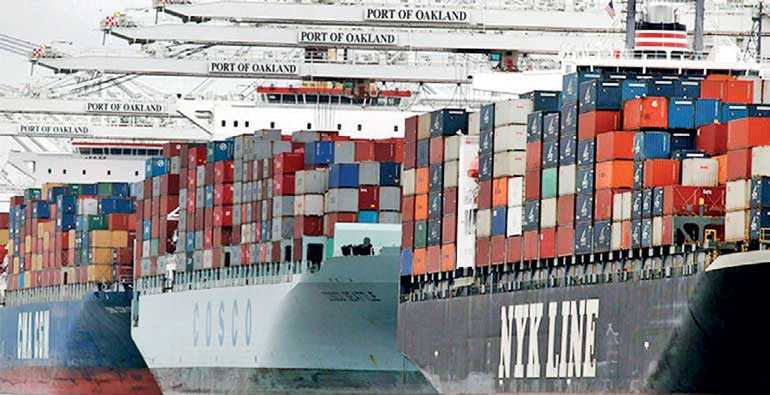Thursday Dec 04, 2025
Thursday Dec 04, 2025
Tuesday, 2 October 2018 00:00 - - {{hitsCtrl.values.hits}}

Being the largest global importer, USA imported $ 2,120 b in 2016, which means it’s helping the rest of the world to come up economically. Despite protectionist rhetoric, a stronger US economy would be better for a wider set of countries, who could export their products and services to a stronger market in USA. However selected countries such as China would be affected by the trade wars
Is there a global economic crisis or a currency crisis, as some people claim?
The largest national economy is getting stronger
The US economy hasn’t grown over 3% since 2005. According to analysts, they are likely to reach that in 2018. In other words, the US economy is seemingly coming out of over a decade of slow growth. Being the largest economy in the world and the most influential, shouldn’t that be good news to the rest of the world?
Being the largest global importer, USA imported $ 2,120 b in 2016, which means it’s helping the rest of the world to come up economically. Despite protectionist rhetoric, a stronger US economy would be better for a wider set of countries, who could export their products and services to a stronger market in USA. However selected countries such as China would be affected by the trade wars.
USA’s path to recovery
During the global financial crisis in 2008-2009, the Federal Funds Rate (the policy interest rate of USA) was brought down sharply from about 5% to almost 0%. As the US economy remained weak, the rate was kept at that level for a number of years.
As the US economy gradually recovered, the Federal Funds Rate was increased for the first time (although marginally) in December 2015. Since then the rates were increased somewhat rapidly in 2017 and 2018, and is currently at 2.25%. This is higher than 0%, although still significantly lower from 5%, where it was in 2007.
Therefore the increasing trend in US interest rates was abundantly clear from way back in late 2015. The Federal Reserve of USA (the Central Bank of USA) has given ample notice to both USA and the rest of the world of its roadmap and has done it gradually to avoid any major volatility.
The performance of the US Dollar
While a lot of talk has taken place regarding the strength of the US Dollar in 2018, it is just part of the full story. The US Dollar Index, which tracks the performance of the US Dollar against a basket of currencies show that the US Dollar actually weakened sharply in 2017 (US Dollar Index declined from 100 to 90). The US Dollar depreciated against most global currencies in 2017. The Index has increased to 95 in 2018 so far but still lower compared to where it was at the end of 2016.
Usually the currencies tend to strengthen when the treasury rates are increased and therefore with the rising trend in US interest rates, analysts were expecting an obvious strengthening of the US Dollar.
Currency worries of certain countries
Some countries such as India, Indonesia and Sri Lanka have witnessed severe depreciating pressures on their currencies in recent weeks. Unfortunately it indicates to poor policy action over the last two years rather than a sudden global phenomenon.
As countries that face external current account deficits, these countries should have been aware of the impact of the clear signs of increasing interest rates in USA and strengthening of the US Dollar from late 2015. A critical policy mistake of all these countries was to allow treasury rates decrease in 2016 and 2017 when the US interest rates were increasing.
Better professional judgment should have resulted in at least maintaining the treasury rates, which would have vastly reduced the recent foreign outflows in the treasury markets of these countries. It is the sudden foreign outflows in treasury markets which almost always shock currencies and it was no exception this time around. While these Central Banks have scampered to raise treasury rates in recent weeks, the damage was already done in 2017 and the early part of 2018.
There is some truth to the fact that during the low interest rate global environment from 2010-2015, some of these emerging markets have resorted to heavy foreign borrowings which may add strain in the future as US interest rates increase.
However as long as the US economy is growing steadily, it would help the global economy and rolling over of foreign debt in these countries could occur without disastrous outcomes. Although policy mistakes such as above could create anxiety and uncertainty in selected emerging markets.
A comparison with global crisis in 2008
In contrast, the global financial crisis in 2008 started in USA. The US economy was in recession in 2008 and 2009. While it started with the crash in the US housing market, it led to bankruptcies in large financial institutions such as Lehman Brothers and the US Government had to bail out both the Financial and Automobile industries.
Being the largest economy and the most influential in the world, the crisis in USA affected the rest of the global economy significantly. The global economy contracted in 2009. In comparison, currently the global economy is growing steadily at around 3%.
Therefore the current global context is quite contradictory to what occurred in 2008. The Chinese economy may face strain from the current trade war, although the world would notice a slowdown in China a lot less than a crisis in USA. The facts and statistics show that the global economy is getting stronger and emerging and smaller economies could also reap benefits provided their authorities set policies wisely.
(The writers could be contacted via [email protected])